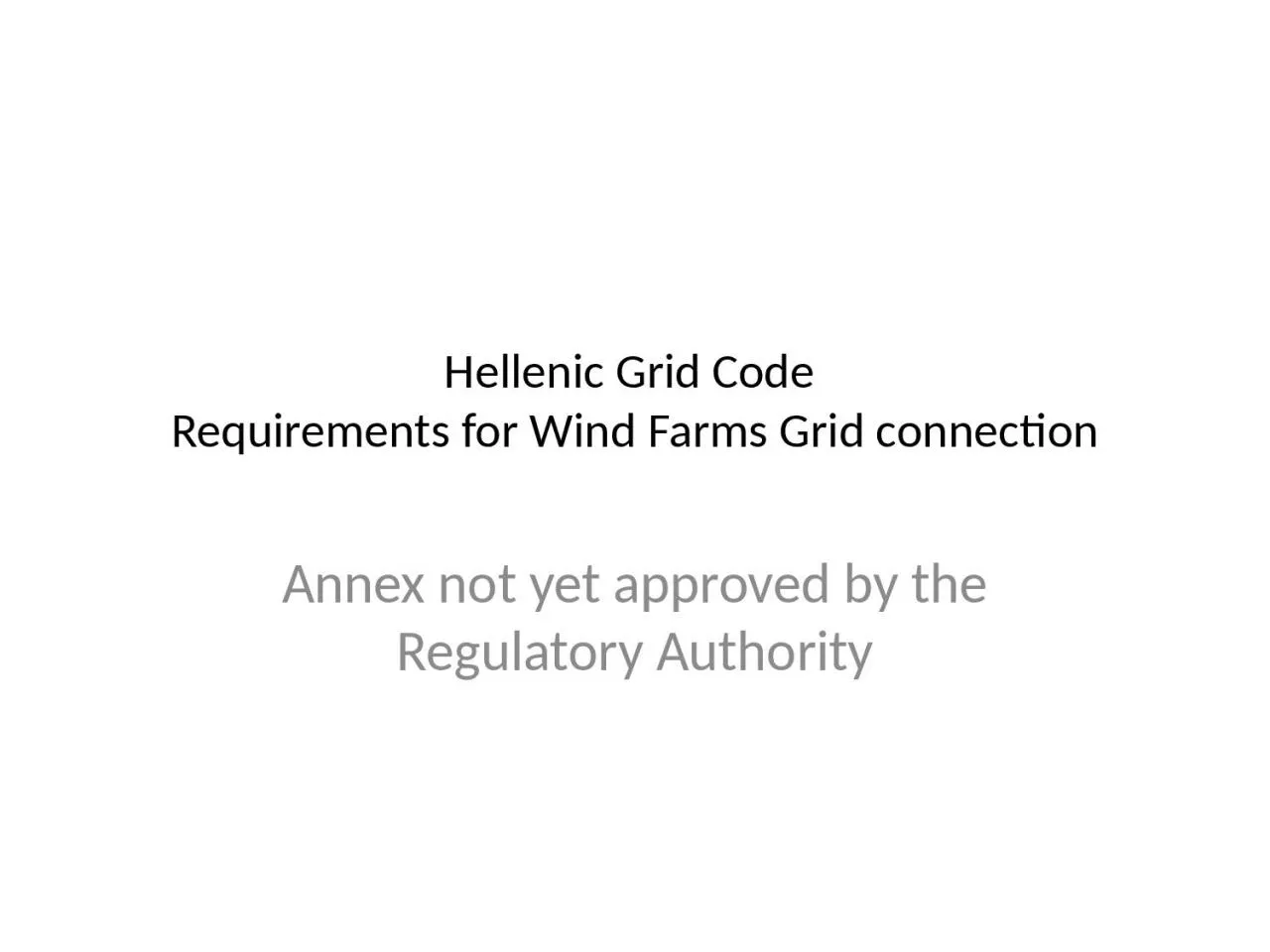

for Wind Farms Grid connection Annex not yet approved by the Regulatory Authority Requirements for Wind Farms WFs Grid connection Frequency and Voltage Operation Boundaries All WTGs should stay connected within the boundary ID: 1015002
Download Presentation The PPT/PDF document "Hellenic Grid Code Requirements" is the property of its rightful owner. Permission is granted to download and print the materials on this web site for personal, non-commercial use only, and to display it on your personal computer provided you do not modify the materials and that you retain all copyright notices contained in the materials. By downloading content from our website, you accept the terms of this agreement.
1. Hellenic Grid Code Requirements for Wind Farms Grid connectionAnnex not yet approved by the Regulatory Authority
2. Requirements for Wind Farms (WFs) Grid connectionFrequency and Voltage Operation BoundariesAll WTGs should stay connected within the boundary 47.0 - 51.5 Hz All WTGs should disconnect with no delay for system frequency < 47Hz The disconnection of WTGs for system frequency > 51.5Hz takes place in 4 steps, with a 0.5sec delay between each stepIn each step, 25% of the operating WTGs is disconnected Applicable to all WFs2
3. Requirements for Wind Farms (WFs) Grid connectionActive/Reactive Power BoundariesUpper diagram : Q-V curveWithin the no-striped area (PF> 0.95) the WF should operate at it’s nominal capacityWithin the striped area (0.835 <PF<0.95), WFs active power is limited according the lower diagramLower diagram : Q-P/Pmax curveThe WF should operate within the polygonal curve with a lower allowed PF=0.835 (inductive or capacitive) WF operation within the striped triangular area (P<20%) is optionalActive, reactive power and the power factor are measured in the MV side of the WF 150/20 step up transformerApplicable to WFs with installed capacity > 10 MW
4. Requirements for Wind Farms (WFs) Grid connectionVoltage/Reactive Power ControlUpon TSO’s request, the WF should operate in voltage, reactive power or PF control modeVoltage regulation is applied at system connection point (HV/150kV), reactive power and power factor regulation is applied at the MV (20kV) side of WF step up transformerThe WF should be equipped with voltage/reactive power regulator according a HV Q–V characteristic The slope and the reference value Vset (zero reactive power injection at the MV (20kV) side of WF step up transformer are defined by the TSOThe desired value of the controlled quantity should be implemented within 30sec after signal receivingspeed of regulation response : in a voltage step change at the connection point (or a step change of reactive power or power factor reference value) the reactive power of the WF should reach 90% of the steady state value in less than 1sApplicable to WFs with installed capacity > 10 MW
5. Requirements for Wind Farms (WFs) Grid connectionLoad-Frequency controlAt TSO’s command, the WF should change the active power ramp up/down rate (±MW/min)Min and max limits of ramp up/down rates are set by the TSOActive power measurement applies at the MV (20kV) side of WF step up (150/20) transformer The WF should be equipped with a load-frequency controller (characteristic f-P) Frequency measurement precision ±10mHz Points Β and Γ define a dead zone within the WF should operate with a constant percentage (% P/Pmax) of the available active powerTable values are defined by the TSOTSO’s command for reduction of the production should be implemented within 60s after signal receivingApplicable to WFs with installed capacity > 10 MW
6. Requirements for Wind Farms (WFs) Grid connectionLow Voltage Ride Through capabilityApplicable to all WTGs, voltage is measured at the HV connection pointDisconnection is allowed in area 1 Reconnection after fault clearance, within 2sec, with a rate 10-20% Pmax/secDisconnection is allowed in area 2 Disconnection in 4 steps, with 0.3sec delay between each step, shed 25% of WFs WTGS at each stepReconnection when the voltage at the connection point (HV) is greater than 142,5kV or 380 kVAfter fault clearance, WTGs not disconnected should increase their production with a rate of 10-20% Pmax/sec Reactive current control WTG nominal values Ηare the reference valuesFor a ±10% Vnom voltage change, the control is activated within 20msec after fault detectionProvision of reactive current ± 2% Ιnom for each ±1% ΔVnomFor voltage sags 50% Vnom , provision of reactive current +100 % Ιnom within 70 msec after fault detection Provision of reactive current applies for 500 msec after voltage recovery within ±10% Vnom band